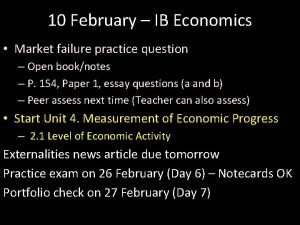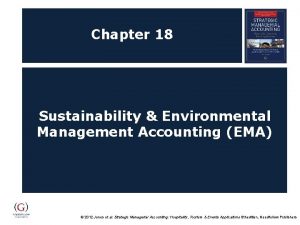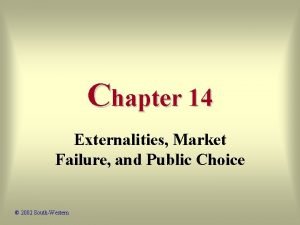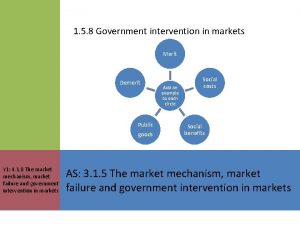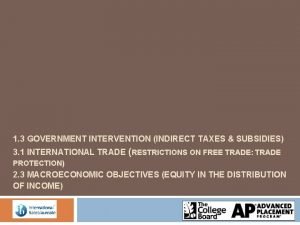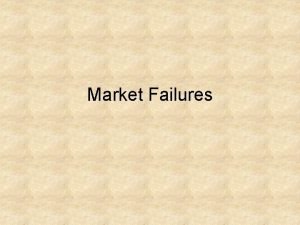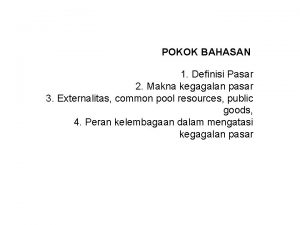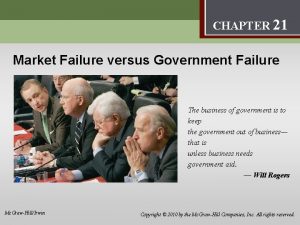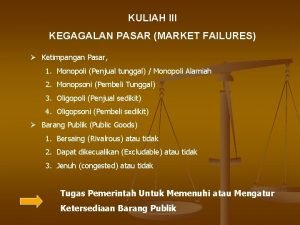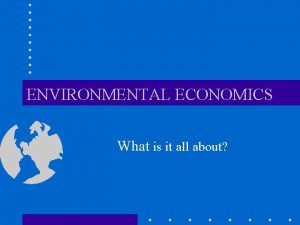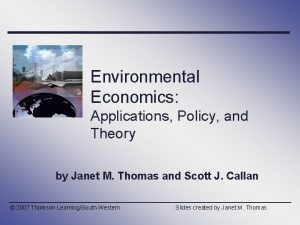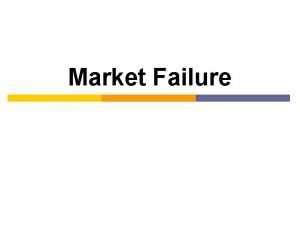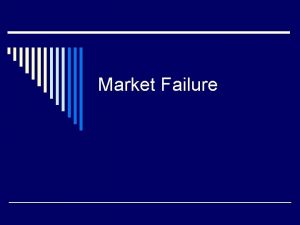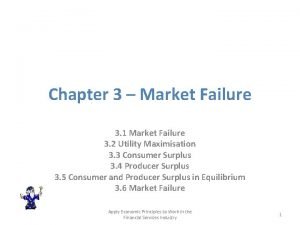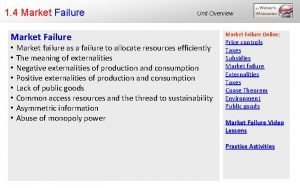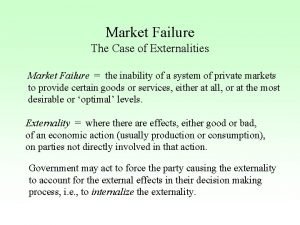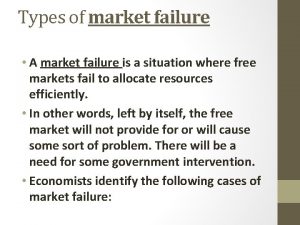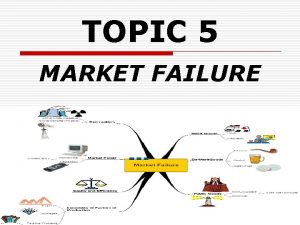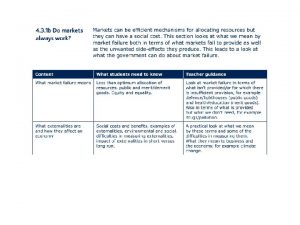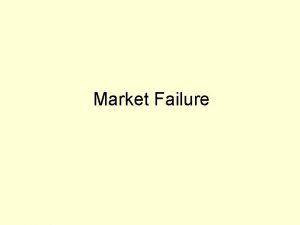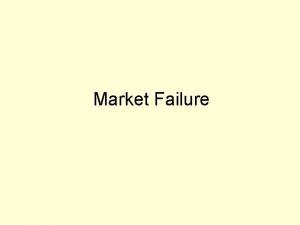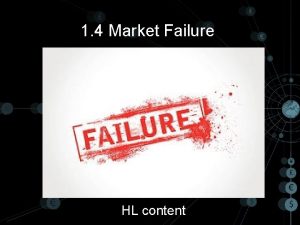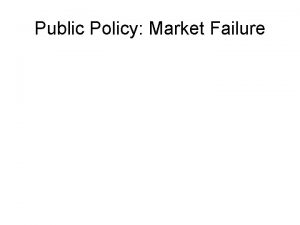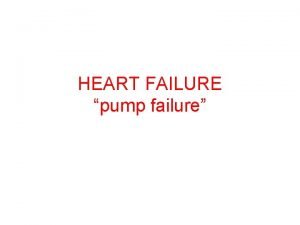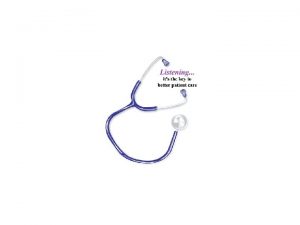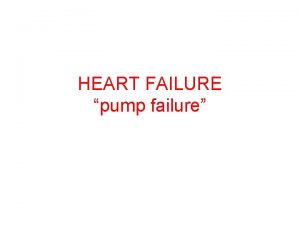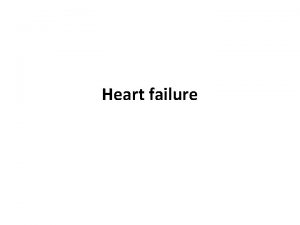Environmental Economics Week 2 MARKET FAILURE AND ENVIRONMENTAL
























- Slides: 24

Environmental Economics Week 2 MARKET FAILURE AND ENVIRONMENTAL ECONOMICS READING: • Common: Chapter 4 • Perman et al: Chapter 5 and 6

SOME ENVIRONMENTAL PROBLEM AREAS • • • Global climate change • greenhouse gases • ozone depletion International air pollution • acid rain Local air pollution • particulates and ozone smogs Water pollution • nitrate spillovers Water scarcity Miscellaneous • Intensive agriculture • Population conglomeration • Loss of biodiversity & irreversible eco-system change • Soil fertility losses • Accumulation of toxins in various media

ALL OF THESE CAN USEFULLY BE ANALYSED UNDER THE FRAMEWORK OF MARKET FAILURE

MARKET EQUILIBRIUM OUTCOMES UNDER “IDEAL” CONDITIONS S = MC = SMC (social marginal cost) D = MB = SMB (social marginal benefit) That is: • market supply properly takes account of all relevant costs • market demand properly takes account of all relevant benefits • And so the competitive market mechanism generates a maximisation of SOCIAL net benefits.

MARKET EQUILIBRIUM OUTCOMES UNDER “IDEAL” CONDITIONS S = MC = SMC (social marginal cost) D = MB = SMB (social marginal benefit) • Also note that consumer and producer surpluses (= social surplus) are maximised. • But market economies in practice do not satisfy the set of ideal conditions, and so privately optimal outcomes do NOT lead to socially optimal ones.

MARKET FAILURE OCCURS WHERE ONE OR MORE OF THESE CONDITIONS IS NOT SATISFIED (AND AN INEFFICIENT OUTCOME OCCURS AS A RESULT). We focus in this course on two kinds of market failure: EXTERNALITY • An externality arises when the activity of a firm or household gives rise to unintended consequences for other firms or households, and do not figure in the costs or benefits of the activity as perceived by the originating firm or household. PUBLIC GOOD • A public good has the property of non-rivalry; that is, consumption of it by one person does not reduce the amount of it available for others.

EXTERNALITIES An externality occurs when an activity generates unintended effects on others for which no payment or compensation is made. Externalities arise because of the absence of private property rights – if they existed payment/compensation would occur. • Externalities can be thought of as “missing markets”. • Or, as unpriced goods and services. • Externalities may be beneficial or harmful In the absence of corrective policy, the level of an activity that gives rise to a harmful/beneficial externality will be too high/low.

Externality Originating In Beneficial Production Activity Honey production Fossil fuel combustion Atmospheric Pollination for pollution fruit growing Externality Consumption Activity Externality Vaccination of one person Reduced risk of infection for rest of population Harmful High stereo volume in apartment Noise pollution A classification of externalities

Two ways of visually showing how externalities lead to a divergence between privately efficient (market) and socially efficient outcomes. In the diagrams, we have an adverse externality such that social costs exceed private costs.

B, C SC = C + External cost C B Q** Q* Q

Price SMC = PMC + EMC P** P* EMC PMB Q** Q* Quantity period

Note at Q* that SMC SMB But it does at Q** (i. e. in the situation where the externality is internalised).

Situation where no externality exists P S Consumer Surplus P* Producer Surplus D Q* Q

The efficiency loss due to an externality P SMC S = PMC P** P* D = SMB Q** Q* Q

Consumer and producer surpluses with an externality P SMC S = PMC CS P** D = SMB Q** Q* Q

Efficiency loss from ignoring externality = NB 1 - NB 2 NB NB without externality NB 0 NB 1 NB 2 NB incl externality Q** Q* Q

PUBLIC GOODS/PUBLIC BADS External effects often have the characteristics of public goods/bads.

Public goods/bads have two characteristics 1. Non-rivalry – consumption by one agent does not reduce the amount available to others 2. Non-excludability – if provided for one agent, others cannot be excluded from consumption Examples of public goods – national defence, lighthouses, air pollution abatement. Examples of public bads – air pollution

Externality Originating In Beneficial Production Activity Honey production Fossil fuel combustion Atmospheric Pollination for pollution fruit growing Externality Consumption Activity Externality Vaccination of one person Reduced risk of infection for rest of population Harmful High stereo volume in apartment Noise pollution All of these externalities are non-rivalous and non-excludable; so they are public (goods/bads) externalities.

PROBLEMS ASSOCIATED WITH PUBLIC GOODS/BADS 1. The free-rider problem. So not feasible to supply via markets. 2. Even if there were no free rider problem, non-rivalry may imply zero marginal costs. So efficient price is zero! (For a bridge, for, toll charge should be zero provided there is no congestion). 3. It is difficult to estimate the marginal benefits (or marginal costs) associated with these goods. Why? Think about pollution abatement, as an example.

£ Marginal benefits of pollution abatement

PROBLEMS ASSOCIATED WITH PUBLIC GOODS/BADS Pollution abatement. 1. There may be no market here; so nothing to observe directly. 2. Free rider issues again: will people reveal preferences? 3. Even if the good were traded, then market demand curves would not correctly express socially valuation. (Market demand curves are horizontal sums; we need vertical sums here).


Pollution Control: Two Questions for Public Policy 1. How much pollution should be allowed? What is the policy objective? 2. How to affect polluters’ behaviour so as to bring about the desired level of pollution? What policy instrument to use? We will answer these questions later.
 Ib economics market failure questions
Ib economics market failure questions Xxxyes
Xxxyes Ventricular escape rhythm
Ventricular escape rhythm Failure to fire pacemaker
Failure to fire pacemaker Example of ductile fracture
Example of ductile fracture Positioning and targeting
Positioning and targeting Hypothetical market structure
Hypothetical market structure Week by week plans for documenting children's development
Week by week plans for documenting children's development Environmental management accounting definition
Environmental management accounting definition Maastricht university economics and business economics
Maastricht university economics and business economics Define market failure
Define market failure Role of government in correcting market failure
Role of government in correcting market failure Indirect tax to correct market failure
Indirect tax to correct market failure Incidence of subsidy
Incidence of subsidy Market failure quiz
Market failure quiz Market failures
Market failures Types of market failure
Types of market failure Pengertian market failure
Pengertian market failure Market failure examples
Market failure examples Pengertian market failure
Pengertian market failure Chapter 2 economics and environmental policy
Chapter 2 economics and environmental policy Mathematical vs non mathematical economics
Mathematical vs non mathematical economics Externalities in environmental economics
Externalities in environmental economics Scope of environmental economics
Scope of environmental economics Scope of environmental economics
Scope of environmental economics
